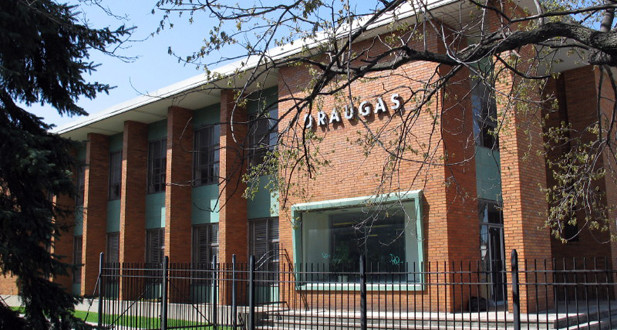Reprinted with permission from LITUANUS (LITHUANIAN QUARTERLY JOURNAL OF ARTS AND SCIENCES).
The original article with Appendices and hyperlinks is available free of charge from the lituanus.org website.
ISSN 0024-5089 Copyright © 2009 LITUANUS Foundation, Inc.
www.lituanus.org
Volume 55, No.4 – Winter 2009
Editor of this issue: Danguolė Kviklys.
DANGUOLĖ KVIKLYS received a M.A. in History from the University of Illinois at Chicago and a M.L.I.S. in Library Science from Kent State University. She has worked as a business reference librarian at DePaul University and is now a research analyst for a communication product manufacturer.
This Winter 2009 issue of Lituanus is dedicated to Draugas (The Friend), a Chicago-based Lithuanian language Catholic newspaper that is celebrating its centennial this year and is the longest published Lithuanian daily in the world.
ACKNOWLEDGEMENTS
I would like to express my foremost gratitude to Lituanus Board members Arvydas Tamulis, Dalia Anysas, and Jurgis Anysas for their support in editing this issue and for very generously donating their time helping me research and photograph the Draugas archives. I am also very thankful to the following persons for their contributions: Jonas Kuprys, the technical editor at Draugas, for helping with fact verification and photographing Draugas archival materials; Aurelija Tamošiūnaitė, Mykolas Drunga, and Daiva Markelis for contributing material; the article reviewers for their comments; Rimas Černius for his translations; Brian DeHart of DePaul University Libraries for his reference assistance; Daiva Markelis, Elizabeth Novickas, and Kristina Vaičikonis for reviewing the writing style of the articles; Ben Kroup and Henrietta Vepštas for their patience with a novice editor; and staff members at the Draugas archives, the Lithuanian Studies and Research Center in Chicago, Kent State University Library, the Lithuanian Emigration Institute at Vytautas Magnus University in Kaunas, and the Martynas Mažvydas National Library of Lithuania for sharing information and providing access to their materials. Photographs published in this issue were taken from “Draugui” – 100: už tikėjimą ir lietuvybę. Newspaper reprints were photographed by Jurgis Anysas, Arvydas Tamulis, and Jonas Kuprys. Finally, a special thank you to Mindaugas Vygantas for initiating this project.
Danguolė Kviklys, Guest Editor
ABSTRACT
Established in 1909, this year Draugas (The Friend), a Chicago-based Lithuanian language Catholic daily newspaper, is celebrating its centennial. It is the only daily Lithuanian newspaper in the world to be published without interruption in the last century, providing a unique and underutilized repository of historical information. This article reviews this Lithuanian-American paper’s origins and history.
Introduction
For one hundred years, Draugas (The Friend), a Chicago-based Lithuanian language Catholic newspaper, like a steadfast, reliable companion, has arrived daily to readers’ homes, informing them of history’s extraordinary events as well as the ordinary ones. The revolutions of the last century, Lithuania’s gain of independence in 1918, its subsequent loss to Soviet and Nazi invaders during World War II, and its miraculous rebirth in 1990 were just a few examples of monumental developments captured by its headlines. Beyond the front page, the paper chronicled the day-to-day life of the Lithuanian-American community, giving foremost attention to its events and festivities. More importantly, it wrote about its people – their thoughts, values, achievements, contributions, and deaths, leaving a historical paper trail depicting where and how they lived, worked, and celebrated.
Established in the United States in 1909, Draugas was never discontinued because of war or occupation like newspapers published in Lithuania. Today, it has the distinction of being the only daily Lithuanian newspaper in the world to be published without interruption throughout the last century, providing a unique and underutilized repository of historical information. By providing a preliminary overview of this paper’s past, this article’s intent is to encourage future researchers to provide much needed critical analysis of its content and its impact on the Lithuanian-American community as well as Lithuania. The extensive unexplored primary and secondary source material found in Draugas may be very useful to genealogists, historians, sociologists, and anthropologists studying Lithuania and its diaspora.
Literature Review
While Lithuanian publications, such as the cultural review Aidai (Echoes), only published a few brief overviews about Draugas, and the monthly Akiračiai (Horizons) commented on its viewpoints, no scholarly studies or in-depth analytical articles exclusively examining the paper’s history or editorial content have been published1. On March 19-20, 2009, in honor of Draugas’s centennial, the Lithuanian Emigration Institute at Vytautas Magnus University in Kaunas (http://www.iseivijosinstitutas.lt/), hosted a conference about the Lithuanian diaspora press. Several papers in Lithuanian about Draugas were presented, laying the groundwork for future study.2 Also, earlier this year, the Lithuanian Catholic Press Society published a commemorative book entitled „Draugui” – 100: Už tikėjimą ir lietuvybę (Draugas – 100: For Faith and Lithuania) in Lithuanian. Compiled by Marija Bareikaitė Remienė and edited by Audronė Viktorija Škiudaitė, the book, which is targeted to a broad audience, provides an interesting selection of original and reprinted articles, some of it primary source material, about the paper’s founders, editors and staff. The book’s presentation took place on July 9, 2009, in Lithuania at the Vilnius National Art Gallery. Juozas Skirius, Chair of the History Department at the Vilnius Pedagogical University, provided an overview of the history of Draugas, highlighting its development and contribution to Lithuanian culture.3
Since certain historical administrative records of Draugas and its owners, the Lithuanian Catholic Press Society, either never existed or were discarded, it is very difficult to assess accurately the extent of the paper’s circulation, to determine who worked there, and gain a more in-depth insight into the paper’s operations. Information about the paper for this article was gathered mostly from biographies about the paper’s founders, the Lithuanian and English language versions of the Lithuanian encyclopedia published in Boston, and decennially issued booklets and articles marking its anniversary. Since dates and events in some of these sources often conflict, preference was given to those articles written by persons who had actually worked at Draugas and witnessed developments there first-hand. Particularly valuable was the November 14, 1959, expanded fiftieth year anniversary issue of Draugas, where a few former editors and staff reminisced about the paper’s early years.4 As this article was being written, the issues dating from 1909 through 1940 located at the paper’s office were sent off-site for microfilming and were not available. Because of time constraints and accessibility issues, only a cursory de visu examination of selected newspaper issues in each decade was completed.
Draugas Holdings in Libraries and Archives in the United States and Lithuania
Locating and accessing past issues of Draugas poses a serious challenge to anyone who needs to locate information from the paper, and greatly impedes its use as a reference source or research tool. Issues published during the last three years have been scanned into PDF format, but the paper’s website (www.draugas.org) is not yet set up to provide access to its complete content. Archival issues of Draugas are not available in a searchable digital format, and no institution, not even the paper’s administrative offices, possesses a complete collection of the newspapers. Although missing issues from the years 1912, 1913, and 1918, the archives at Draugas have the most complete print format collection, and the Lithuanian Studies and Research Center in Chicago holds the second largest. The Library of Congress and the Center for Research Libraries have the most extensive microfilm collections. (For issues of Draugas at U.S. libraries and institutions, see Appendix A.)
In Lithuania, a complete archival collection of Draugas is also not available. Silvija Velavičienė, head of the Lituanica section at the Martynas Mažvydas National Library of Lithuania in Vilnius, discusses reasons for this in her recent Knygotyra and Lituanus articles about KGB censorship.5 During World War II, many libraries were ransacked, damaged or destroyed, and their collections perished. During the subsequent Soviet occupation of Lithuania from 1944 to 1990, library acquisitions from the West were severely restricted, and access to Western publications was limited to those with special permission. During the 1950s, émigré publications, branded as dangerous and counterrevolutionary, were acquired only by Soviet KGB-related agencies closely monitoring émigré activity. An exemption was given to the Lithuanian Communist Party History Institute’s library, which was entrusted with collecting and safeguarding the materials. Later, in the 1960s, the Mažvydas National Library, which is responsible for collecting all Lithuanian publications, was allowed to receive émigré publications, but had to store them in restricted, high security areas, referred to as specfondai. Surprisingly, after Lithuania regained its independence in 1990 and the Soviet-controlled institutions disbanded, the émigré collections that supposedly were conscientiously collected and guarded were mysteriously incomplete.
Since 1990, the Mažvydas National Library has systematically collected and retained all issues of Draugas and makes them available to the public. Its electronic catalog lists all issues in the collection from 1949 to the present. Some earlier uncataloged issues are also available upon request. Lacking funding for microfilming, the collection remains only in print format. There are other academic and public libraries in the country that have copies of Draugas, but their holdings are not extensive and remain largely uncataloged (see Appendix B).
Only a small percentage of articles from the hundred-year compilation of Draugas are indexed, so it is difficult to determine its contents without laboriously examining each page. Articles published in the Saturday’s cultural supplement have been indexed annually since 1973, but since the index is embedded in one of the paper’s year-end issues, it can be inadvertently overlooked. Between 1970 and 1979, bibliographic citations of selected articles published in Draugas were also recorded in the two-volume work The Bibliography of the Lithuanian Press Outside Lithuania, published in Chicago. Since 2003, the Mažvydas National Library has included Draugas in LIBIS (http://www.libis.lt:8082/), its internet-accessible, national bibliographic database, which registers all Lithuanian-related publications. Currently, this database contains over 8,000 bibliographic citations of articles written exclusively for Draugas and it is searchable by author, title or keyword. Articles in Draugas reprinted from various Lithuanian press sources are excluded.
Lithuanians in the United States
When Draugas was founded, there were probably over 250,000 Lithuanians living in the United States, mostly on the East Coast, in Pennsylvania’s coal mining region, or throughout the Midwest.6 Lithuania had a poor agrarian economy and was incorporated into the Russian empire in the late eighteenth century. Many Lithuanians came to the United States searching for better economic prospects, but a significant minority also arrived to escape political persecution. The czarist government, after a failed 1863-64 Lithuanian-Polish insurrection, introduced a series of oppressive measures intending to eradicate the Lithuanian language and culture and to assimilate the population into the rest of its empire. Lithuanian men were conscripted into the czarist army, and were frequently forced to serve twenty-five-year terms in the empire’s outlying areas, far from their families and homes. Between 1865 and 1904, a press ban was enacted that forbade publishing and disseminating Lithuanian language publications in the Latin alphabet. The few private schools that were operating were closed and replaced by Russian ones.
Lithuanians actively resisted attempts at Russification. In order to protect their youth from Russian indoctrination, Lithuanians boycotted Russian schools and sought to educate their children at home. Refusing to adopt the Cyrillic alphabet, Lithuanians published their books and periodicals in East Prussia or the United States, and then smuggled them back into Lithuania. Rather than serve in the czarist army, many Lithuanians immigrated to the United States. Repressive czarist policies were counterproductive and encouraged the growth of a Lithuanian nationalist movement, which eventually culminated in regaining the country’s independence.
Lithuanian-American Press Prior to 1920
The majority of Lithuanians who came to the United States in the 1860s were barely literate7 and lacked a strong sense of national identity. Frequently, they identified themselves with the Poles, with whom they had once formed a commonwealth, and this confusion was reflected in their early press. The first Lithuanian newspaper in the United States, the weekly Lietuwiszka Gazieta (The Lithuanian Gazette), appeared in New York City in 1879 and was published and edited by Mykolas Tvarauskis, who was at odds with some Lithuanians because he advocated a Polish-Lithuanian confederation. With only 132 subscribers, the paper failed to last a year. There were a few subsequent pro-Polish Lithuanian publications, among them the long-running Saulė (The Sun) in Mahanoy City, Pennsylvania, published between 1888 and 1952. Saulė remained a linguistic anomaly because it never adopted conventional Lithuanian grammar or spelling rules, and published mostly translations of poorer-quality Polish literature.
By the turn of the century, some Lithuanian-Americans had lost interest in their native land and had assimilated into American culture. Others, however, thought it important to retain their own unique identity and developed an interest in their heritage and homeland. The fostering of the latter sentiment was mainly the work of a minority of Lithuanian-educated professionals who were national activists and foresaw the possibility of Lithuania again becoming a nation-state. Intent on raising the national consciousness of their compatriots so that they could eventually return to their homeland to rebuild it, they established churches, founded organizations and published Lithuanian-language books and periodicals. Although they shared common national aspirations, these activists failed to work together and were deeply divided into two opposing groups: clerical vs. secular. The clerical supporters believed that only Catholics could be good Lithuanians, while their secular opponents countered that religious beliefs had nothing to do with national loyalty. David Fainhauz in his book Lithuanians in the USA: Aspects of Ethnic Identity8 provides a more extensive analysis of prevailing ideologies in the early Lithuanian-American community.
Prior to World War I, Lithuanian-Americans were definitely not a homogenous group, and this was reflected in the wide range of viewpoints represented by their publications.9 For example, in Chicago, for the radically inclined, there was Anarchistas (The Anarchist); for members of a “national church” called St. Peter‘s Cathedral (Šv. Petro Katedra), there was Žemaitis (The Samogitian); for the socialist, an art and science journal called Lietuvių žurnalas (Lithuanian Journal); and for those who loved satire and humor, Šakė (Pitchfork).10 It is difficult to determine the exact number of periodicals published in the United States at the beginning of the twentieth century because many of them were of such short duration. About twenty years ago, Julius Tamošiūnas compiled a bibliography that recorded a total of 3,289 Lithuanian periodicals published in twenty-five countries between 1832 and 1982, of which about 15 percent were published in the United States.11 Vaclovas Biržiška, one of Lithuania’s foremost bibliographers, estimated that between 1874 and 1910, seventy-nine periodicals were published in the United States.12 Alex Ambrose, in The History of Chicago Lithuanians, provides annotations for 121 periodicals published between 1886 and 1960, of which about thirty-eight titles were introduced between 1910 and 1920. None of these bibliographies provided press run information.
While many of the early periodicals lasted only a few years, those representing the laisvamaniai (freethinkers), socialists, communists, nationalists, and Catholics had longer staying power, and a few of them would become formidable competitors to Draugas. Jonas Šliūpas, a physician, self-proclaimed freethinker, and secular rights advocate, was the most popular publisher and author. His work probably spurred the Catholics to establish their own press. A complex personality, Šliūpas befriended several Catholic clergymen, but disliked many others, whom he blamed for Polonizing the Lithuanians or attempting to control them. Known for his aggressive antireligious agitation, Šliūpas was frequently accused of inciting and dividing the Lithuanian-American community. During the thirty-five years he spent in the U.S. before returning to Lithuania, he consecutively published five newspapers, which his critics contended repeatedly failed because their readers were eventually alienated by his strident rhetoric. Lietuviškasis Balsas (The Lithuanian Voice,1885-89) and Laisvoji Mintis (Free Thought, 1910-15) were his best-known and longest-running publications.13 Lithuanians seeking relief from intense ideological debates could subscribe to a more moderate, nationalist-oriented publication such as Lietuva (Lithuania, 1892-1920), founded by Chicago entrepreneur Antanas Olšauskis (a.k.a. Olševskis), which published articles about political developments in Lithuania, popular science, and other informative but less controversial topics.
Jonas Balys, former head of the Baltic section at the Library of Congress, in an article about the Lithuanian-American press in Lituanus, listed fifteen newspapers being published in North America in 1976.14 Like Draugas, most were founded in the first two decades of the last century, but today, only three from that group remain: Tėviškės žiburiai (The Lights of the Homeland), a Canadian weekly; Dirva (The Field), a bi-weekly once aligned with the pre-WWII Lithuanian Nationalist party; and Tevynė (Fatherland), the official publication of the Lithuanian Alliance of America, now a biannual. The majority of the fifteen newspapers on the list had socialist or communist roots. Since many Lithuanians were employed under harsh working conditions in the coal mines or in industries such as Chicago’s infamous stockyards, organizations promoting social justice were very influential and their publications appealing. Naujienos (The News), a daily paper established in Chicago by the socialists in 1914, was considered to be Draugas’s arch rival. Edited by Pijus Grigaitis from its inception to his death in 1969, Naujienos for many years provided non-Catholics and more secular-oriented readers with an alternative to the Catholic conservative Draugas. Naujienos ceased being a competitor to Draugas after Grigaitis’s death. Martynas Gudelis became its chief editor and slowly transformed the newspaper from a socialist publication into a slander sheet freely accusing prominent members of the Lithuanian-American community, including the editors of Draugas, of collaborating with the Soviets. These accusations were ironic coming from a person who was a fugitive from the Lithuanian State: Gudelis fled Lithuania in 1929 after allegedly trying to assassinate Prime Minister Augustinas Voldemaras. He fought for the Soviet-supported Republicans during the Spanish Civil War of the 1930s, visited Moscow, and then published a book about his adventures.15
Draugas – The Formative Years
Prior to World War I, the Lithuanian-American Roman Catholic community already had two newspapers, Katalikas (The Catholic, 1898-1917), published first by Rev. Motiejus Kriaučiūnas and later by Jonas Tanevičius, and Žvaigždė (The Star, 1901-1944), published by Rev. Antanas Milukas. From the literature reviewed, it is not quite clear why the Lithuanian community required yet another Catholic publication, but the idea of starting a third one was introduced at a meeting of a newly formed organization of forty-two priests, the Lietuvių kunigų sąjunga (Lithuanian Priests‘ League), which met on May 5, 1909, in New York. Presiding over this event was the League’s main initiator, Rev. Antanas Staniukynas, and Rev. Antanas Kaupas acted as secretary. The League’s goal was to unite the leaders of the widely dispersed Lithuanian parishes into a single organization with the goal of supporting each other, working on common projects, and raising funds. Alarmed by the rapidly declining interest of many Lithuanian-Americans, especially the younger generation, in their national heritage and values, the League determined that it was their obligation to quickly establish a network of Lithuanian Catholic schools and a weekly newspaper that would educate Lithuanians about their history and background. Every League member was required to donate seed money for the paper, an initiation fee of $100.16
Without the financial support of the Priests’ League and the stubborn determination of its two most active members, Rev. Antanas Staniukynas and Rev. Antanas Kaupas, Draugas would never have come to fruition. Besides having common forenames, the men were friends, and both were strong believers in the Lithuanian nationalist movement and the critical role that the Catholic Church had in supporting it. Incredibly industrious in establishing Draugas, both were also involved in other ambitious projects, through which they made significant permanent contributions to the Lithuanian community in the U.S. and the homeland. Both died at an early age: Staniukynas in 1918 at age 53 from tuberculosis and Kaupas in 1913 at age 43 from throat cancer.
Immigrating to the United States in 1904, Staniukynas was a polyglot who already knew English and spoke ten other languages, including Aramaic. After graduating from the Seinai Theological Seminary and being ordained a priest, he continued his studies at Fribourg in Switzerland, Rome, and Jerusalem, eventually receiving a Doctor of Theology from the Biblical Institute in Jerusalem. Initially, he served as pastor of two Lithuanian parishes in Mt. Carmel and Shamokin, Pennsylvania. In 1907, together with Mother Maria Kaupas, he embarked on a mission to establish the Congregation of the Sisters of St. Casimir. A relentless fundraiser, he visited many Lithuanian-American communities, soliciting funds to purchase land and build the Congregation’s motherhouse in Chicago. As the plan for Draugas was being developed, he was already in the midst of overseeing the construction of this state-of-the-art building, which he visited almost daily, traveling several hours each way, to monitor the installation of such innovations as electrical conduit and basement sump pumps. In his spare time, he provided religious and Lithuanian language instruction to the congregation’s novices, translated a catechism into Lithuanian, and published a new Lithuanian edition of the New Testament, adding his own scriptural commentaries. To aid the aged and orphans, many who lost their parents through raging epidemics or mining accidents, he established the Lithuanian Roman Catholic Charities of America. Taking interest in the national movement in Lithuania, he also financially supported various educational and youth organizations, among them Lithuania’s largest Catholic youth organization, Ateitis (The Future).
While Staniukynas focused on securing financial support for Draugas, Kaupas determined the newspaper’s mission and editorial focus, and was its editor-in-chief during its preliminary four years. Expelled from the theological seminary in Kaunas for distributing banned Lithuanian literature, Kaupas spent time in St. Petersburg, Russia, where he developed a life-long interest in sociological issues, but a dislike of Marxism and other prevailing political and social revolutionary theories, which he deemed destructive. Returning from Russia, he immigrated to the United States in 1892 after the czarist police again discovered contraband literature in his possession. Working briefly in Chicago’s stockyards, he later enrolled in Detroit’s Polish Seminary, subsequently renamed S.S. Cyril and Methodius Seminary, completed it, and was ordained a Roman Catholic priest.
Over the course of the next fifteen years, Kaupas served as pastor at three Lithuanian Roman Catholic parishes in Pennsylvania–Wilkes Barre, Scranton, and Pittston, where he oversaw the construction of St. Casimir’s Church. Kaupas‘s pastorate at all three parishes was tumultuous, partly because of inherited long-standing conflicts that he believed were purposefully instigated by the freethinkers, followers of Šliūpas. Debates raged about control of church property, clergy authority, and laity governance rights; some of them ended up being litigated in Pennsylvania’s civil courts.17
The first issue of Draugas was published on July 12, 1909 in Wilkes Barre, Pennsylvania, a city of about 67,000, with a Lithuanian population of about 4,000.18 This city was an active Lithuanian center, which hosted the first Lithuanian Roman Catholic Congress in 1906 and had two Lithuanian Roman Catholic parishes, as well as a national separatist church. All of the 1909 issues were weekly, published in a sixteen page, coverless magazine format, with each edition featuring a new poem on its front page. The price for a one-year subscription was $2.00. Depending on the calculation method, this comes close to $200 in today’s currency, more than the current annual rate of $150.19 The first pres srun was ten thousand copies, and fifteen sales agents throughout the East Coast and Midwest were listed as distributors.20 By mid-year, Draugas received a donation of $3,349 from the Lithuanian Priests’ League to purchase Linotype typesetting equipment, and Kaupas, conscious of the paper’s poor financial condition, declined a salary.21
The origin of the Draugas name was explained in the “mission statement” provided by the editors and publishers (see Appendix C):
“The very name of the newspaper – DRAUGAS – KATALIKIŠKAS LAIKRAŠTIS (The Friend – A Catholic Newspaper) shows that it will be a dear and close friend of Catholics. It is very important for everyone to have a true friend in life. It is to a friend that we turn for help in times of misfortune, for advice in times of doubt and for companionship in times of joy. How more fortunate is it to have a friend who is also so powerful that hundreds and thousands listen to its voice… .”
Disliking the confrontational tactics used by the freethinkers, whom he thought had a very divisive effect on the community, Kaupas was influenced by the writings of various Progressive Era American sociologists. He developed his own social theories, which he expounded frequently in the Lithuanian press and journals.22
Unlike some of the radical theorists of the time who advocated revolution to achieve social justice, Kaupas promoted a more evolutionary approach, emphasizing the necessity of striving for unity, harmony, and compromise to achieve social change or reach any long-term goal. His emphasis on amicable relations was conveyed in Draugas’s mission statement:
“We are publishing Draugas because we desire the well-being, love and concord of Lithuanian Catholics… We will publish this newspaper in the Catholic spirit. Let our mottoes be the famous words of Lincoln: ‘With malice toward none, with charity for all, with firmness in the right, as God gives us to see the right’ and the encouraging advice of Saint Paul: ‘Stand therefore, having girded your loins with truth, and having put on the breastplate of justice.’ (Eph. 6: 14)”23
Examined articles published in the first year of Draugas show that Kaupas selectively applied Lincoln’s motto, and his quest for unity meant that he was searching for followers adhering only to his viewpoints. He believed that Catholics were morally superior to other religious groups partly because he thought that they were more supportive of the workers’ movement.24 He disliked socialists as well as nonbelievers, sometimes attacking them with caustic rhetoric. Well-read, he frequently provided excerpts from American periodicals such as the popular Saturday Evening Post and the scholarly American Journal of Sociology, but his most cited publication was The Independent, a Congregationalist-sponsored weekly with strong abolitionist roots that addressed social and cultural topics. Kaupas, following the abolitionist tradition, expressed empathy for the plight of blacks in America,25 but showed a mistrust of Jews in the very first issue of Draugas, when he printed excerpts from an anti-Semitic article in The Independent that discussed why Jews in America were disliked.26
The negative consequences of Lithuanians assimilating into the American culture, child rearing and school quality issues, and concerns about social problems such as alcohol abuse and inadequate domestic hygiene, received a lot of attention in the early pages of Draugas. Consideration was also given to the trying social and working conditions of the time. Draugas published several pro-labor editorials reminding Lithuanian Catholic churches that because the workers financed them, they were obliged to actively support labor issues such as pay equity and fair working conditions.27 Brief international news digests were also provided, and ample coverage was given to information from Lithuania, the governing Russian Duma, and various U.S. Lithuanian communities.
Since the first issue’s masthead did not identify its editor and articles were signed with pseudonyms, some speculate that it was its administrator, Rev. Vincentas Vizgirda, pastor of Holy Trinity Church in Wilkes Barre, Pennsylvania, who edited the first issue, not Kaupas.28 In 1959, on the occasion of Draugas’s fiftieth anniversary, Vizgirda, who was then residing in Soviet-occupied Lithuania, secretly forwarded a letter to its editors in which he reminisced about preparing the first issue for the press (“parengė spaudai”) with the church’s organist, but he did not specifically describe his duties. Although this assertion might have some validity, the inclusion of citations from Kaupas’s favorite publications, such as The Independent, makes it difficult to believe that Kaupas did not have editorial control over the first issues.
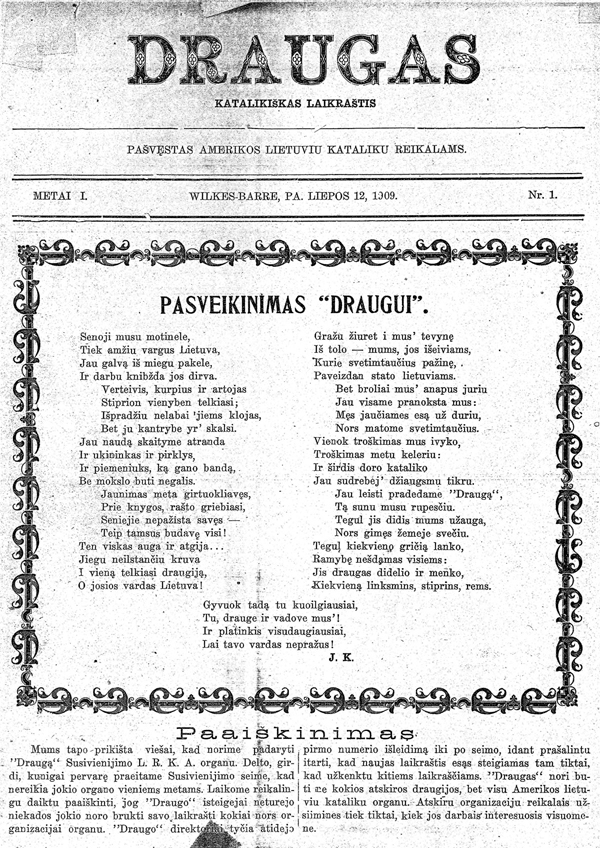
In 1912, Draugas moved to Chicago, which by then had the largest Lithuanian population in the U.S., of over 50,000.29 Twelve Lithuanian Catholic parishes were founded there between 1892 and 1927, offering the paper an opportunity to increase its subscribers by taking advantage of the growing Lithuanian Catholic community. Chicago’s Lithuanian community also had a more vibrant cultural life, and there seemed to be a high interest in reading and self-education, evidenced by the seven volunteer-operated Lithuanian libraries throughout the city, the existence of a large Lithuanian bookstore owned by Antanas Olševskis, and the availability of a multitude of native-language newspapers.30 There was also a small but growing number of Lithuanians receiving higher education degrees, with some attending Chicago area universities, such as Northwestern or the University of Chicago. Over one thousand Lithuanians graduated from nearby Valparaiso University in Indiana, which offered students favorable financial terms and even sponsored a program in Lithuanian studies. Graduates from Valparaiso frequently took on short-term assignments with Draugas as editors or contributors. On July 4, 1912, Draugas published its first weekly edition in Chicago, and on March 31, 1916, it became a daily, issued six days per week for the next sixty-six years until March 1982, when it was reduced to five days.
Stability, Growth and Continuity
The first decade of Draugas was marked by tenuous finances, a high turnover of administrators and editors, and four changes of location.31 New funding, the appointment of long-term editors, and an influx of post-World War II refugees stabilized the paper, ensuring its continuity into the next century. In 1918, three Lithuanian Marian Fathers made a commitment to support the paper and became responsible for its finances and administration. They purchased a four-story building in Chicago’s Pilsen West Side neighborhood, which would be their residence and house the paper’s editorial offices and print shop until 1957. Even after 1941, when the current owners, the Lithuanian Catholic Press Society, Inc., assumed control, the Marian Fathers continued to very generously subsidize the paper until an endowment fund, the Draugas Foundation, Inc., was created in 1993. The 1927 appointment of Leonardas Šimutis as the paper‘s editor-in-chief, a position that he would retain until 1968, and the forty-three year tenure of Ignas Sakalas as its technical editor, stabilized the paper and provided steady editorial leadership.
By 1910, Draugas had adopted the six-page seven-column broadsheet format it continued to use daily until October 1, 2005, when the editor-in-chief, Danutė Bindokienė, gave it a “makeover,“ refashioning it into a more compact twelve-page tabloid format. In its external appearance, Draugas’s front page, which always featured news from around the world, the United States, and Lithuania, remained reassuringly the same throughout the century. Editorially, elements of the paper would also remain unchanged. Draugas always identified itself as a Roman Catholic publication that strictly adhered to the Catholic Church’s doctrines, and, as Kaupas originally intended, avoided conflict and discussion of controversial issues. Draugas refrained from exchanging polemics with rival publications: this sentiment was expressed by Draugas editor-in-chief Rev. Pranciškus Bučys early in the newspaper’s first decade, and reiterated seventy-five years later by his successor Danutė Bindokienė.32 Similarly, the editorial focus of Draugas, as summarized by Leonardas Šimutis on the paper’s fiftieth anniversary, was akin to the one provided fifty years later by the current editor-in-chief, Dalia Cidzikaitė. In 1959, Leonardas Šimutis wrote: 33
“‘Draugas’ organizuoja stato ir kitiems padeda. Jis ragina steigti lietuviškas parapijas, statyti mokyklas, organizuotis, griežtai ir energingai kovoti dėl lietuvių teisių, remti tautos aktualiuosius reikalus. Tuo jis ir skiriasi nuo visų kitų laikraščių. Jis leidžiamas ne del biznio, bet tikybinei ir tautinės sąmonei kelti ir palaikyti, organizuoti ir šviesti. Pigios vertės sensacijoms ’Drauge’ nebuvo ir ligšiol nėra vietos.”
“Draugas organizes, builds, and helps others. It encourages the establishment of Lithuanian parishes and the building of schools. It encourages Lithuanians to organize, to fight for their rights firmly and with energy, and to support current matters of national importance. In this it differs from all other newspapers. It is published not for business, but to raise, maintain, organize, and illuminate religious and national consciousness. Cheap sensationalism has not had and does not have any place in Draugas.”
In 2009, Dalia Cidzikaitė stated: 34
“Mes nesivaikome vienadienių triukšmingų įvykių, skandalų. Norime būti patikimas ir solidus leidinys. Stengiamės daugiau dėmesio skirti tam, kas gerai, o ne aimanuoti dėl blogų dalykų. Jei linktume prie bulvarinės spaudos įpročių, gali būti, kad pritrauktume daugiau vienadienių skaitytojų. Tačiau tai ne ‘Draugo’ kelias.”
“We don’t pursue fleeting raucous events or scandals. We want to be a trusted and reputable publication. We try to direct our attention more toward the good instead of complaining about the bad. If we leaned toward the methods of the sensationalist press, then we might attract more short-term readers. However that is not the path of Draugas.”
Without a thorough review of the paper’s content, it is difficult to determine what editorial positions Draugas took on various issues of the twentieth century or which ones it avoided, but it frequently filtered and published only a one-sided viewpoint. Such a stance, in 1968, gave birth to a rival, more liberal, monthly, Akiračiai (Horizons), which provided alternate opinions on issues Draugas and other Lithuanian publications did not cover or debate.
During World War I and after Lithuania declared its independence in 1918, Draugas played a very active role in soliciting funds and support for the newly forming nation state. Fostering civic responsibility, its articles encouraged Lithuanian-Americans to contribute to various war relief efforts (for example, the 1919 Lithuanian Liberty Fund drive, which raised $1,845,150), and to the establishment of Lithuanian information bureaus in Washington, D.C., and Paris. Lists of donors and their homeaddresses were sometimes published. Notices in the newspaper reminded readers to join the Lithuanian army and to sign a petition to U.S. President Woodrow Wilson demanding recognition of independent Lithuania, which eventually gathered a million signatures.
Between 1918 and 1940, Draugas featured a daily editorial, analyses of Lithuania’s political life, and many articles encouraging Lithuanian-American entrepreneurs to invest in Lithuania. There were stories about the activities and members of various Lithuanian-American communities, with a special focus on youth organizations such as Vyčiai (The Knights of Lithuania), which was founded in 1913. Occasionally it reprinted articles from Lithuania’s press. A health advice column was introduced that still exists today. Display advertising, featuring mostly Lithuanian businesses, was much more abundant than today. Reprints of English language articles from U.S. newspapers were sometimes published when they covered events heavily attended by the Lithuanian community, such as concerts or World’s Fair exhibitions. Also in the early 1940s, Rev. Petras Činikas, the paper‘s administrator, and Šimutis introduced Aplink Mus (Around Us), the popular back page event and gossip column, titled differently today, but still widely read.
Considering that sixty years ago, breaking news events were transmitted by telegraph, a costly communication mode not always affordable by small news organizations such as Draugas, a review of select Draugas issues during World War II shows a timely presentation of war developments, especially those from Lithuania. The first Soviet troops marched into Lituania on June 15, 1940. On Monday, June 17, 1940, Draugas’s headline alarmingly blared „Rusija okupavo Lietuvą – Prezidentas Smetona Vokietijon.“ (Russia has occupied Lithuania – President Smetona to Germany). In 1944, as the Russian front slowly moved through Lithuania, Draugas issued daily, town by town, frontline reports of Russians occupying smaller, outlying places such as Ukmergė or Raseiniai, a remarkable feat considering the chaos of war. One article referred to an anonymous Draugas correspondent providing coverage, but additional research is required to determine what channels Draugas actually used. Many of the printed photographs are attributed to Acme Photo, a news subscription service, and U.S. defense sources.
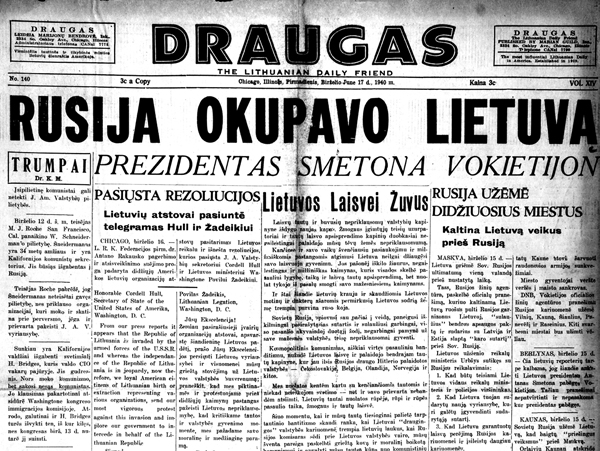
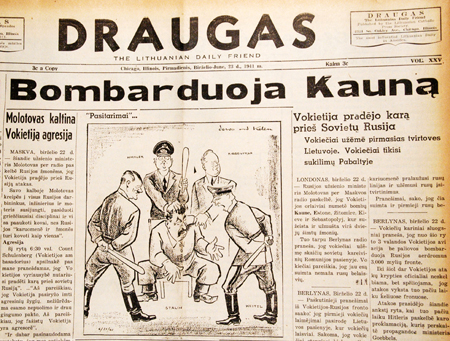
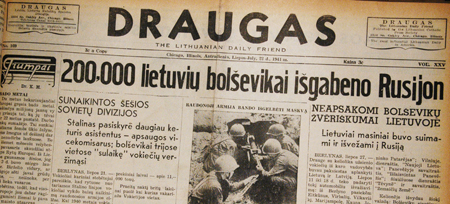



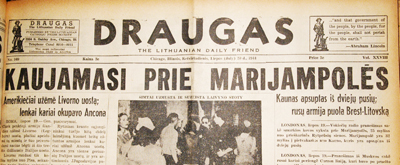
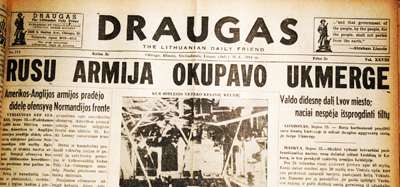
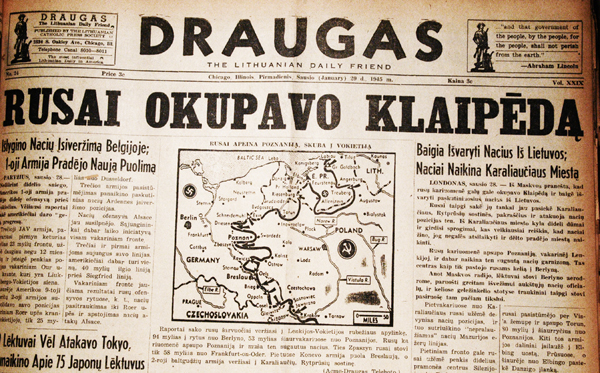
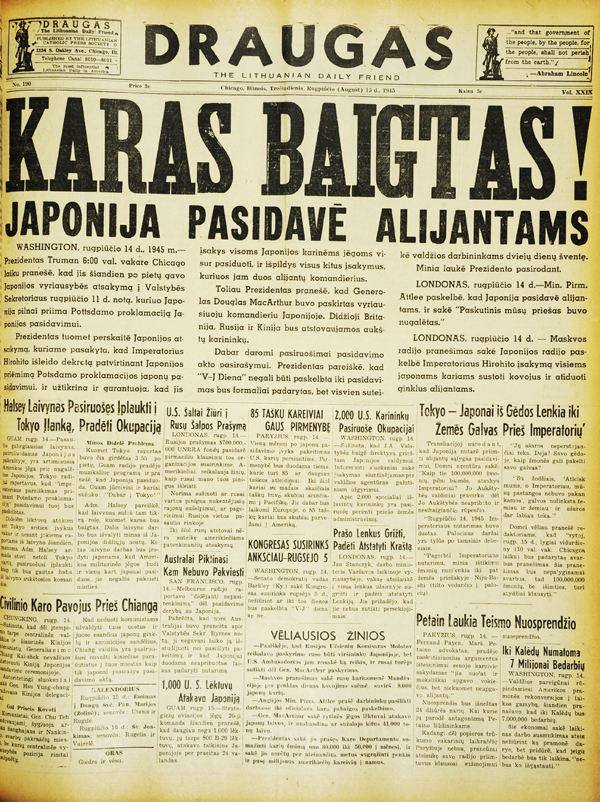
Post-World War II
After World War II, when Lithuania was occupied by the Soviets and lost its independence, about 65,000 Lithuanians fled the country. Most of them ended up in displaced persons’ camps in Germany. Eventually, a majority of about 50,000, settled in North America, but others remained in Europe or emigrated to Australia or South America.35 Unlike earlier Lithuanian immigrants, many of the postwar émigrés were better educated. Their experience of life in independent Lithuania gave them a firm understanding of their national identity. They were also political refugees who, having lost their country, were very committed to preserving their cultural heritage and working to regain Lithuania’s independence. One hallmark of this group’s long lasting cultural contribution was compiling and publishing a thirty-seven-volume Lithuanian encyclopedia and a subsequent six-volume English language edition, covering both Lithuanian and general subjects. The encyclopedias’ sole publisher was Juozas Kapočius of Boston. Its core editorial group consisted of about five modestly paid émigré academicians, who took turns editing single volumes, and about two hundred unpaid subject specialist contributors. These editors and contributors, until about the early 1990s when they retired or died, also wrote for Draugas, frequently enriching the paper with high-caliber content.
Prior to the arrival of the émigrés, Draugas’s circulation had been steadily declining, as the children of previous immigrants were no longer interested in subscribing. An aggressive postwar, nationwide advertisement solicitation campaign increased the paper’s revenue, while free trial subscriptions for newcomers brought new readers. In 1957, both the old and new Lithuanian immigrants contributed $900,000, enabling Draugas to build a new press center that remains its headquarters today. In 1959, it had seven editors and about 1,000 volunteer correspondents.36 Since subscription or paper procurement records are not available, it is difficult to determine how the published circulation figures were derived. In 1963, the paper listed the total number of daily copies printed as 48,150, a high figure that could be questioned, considering the limited availability of paper storage facilities on the premises. Almost ten years later, in 1972, statements show that circulation had plummeted by more than 50 percent, and the total number of copies printed was 22,200. Out of that figure, 14,000 copies were distributed through “carriers, street vendors, agents,” and there were 8,100 mail subscribers. The latter figure might more accurately reflect the true subscription levels, because it is tied directly to postal service rates. In 1983, the average number of copies printed daily was 7,300.37
The new émigré editors and correspondents, all educated in Lithuania or postwar German universities, updated the paper‘s Lithuanian vocabulary and changed its content to reflect their interests. Dispersed all over the world, many Lithuanians kept in touch through global organizations such as the Lithuanian World Community, established in the mid-1950s, Catholic organizations such as Ateitis (The Future), the Lithuanian Scout Association, and various sports associations. Draugas no longer reported on just Lithuanians in America; now it had become global. Correspondents continuosly informed about events taking place in Lithuanian communities in Europe and countries such as Argentina, Venezuela, Brazil, and even Australia. A variety of columns dedicated to humor, social services, women, Lithuanian education, student activities, and religion were also introduced To this day, Ateitis and the Scouts still publish regular weekly columns informing their members and the public about their activities.
Since occupied Lithuania’s press was no longer free, Draugas’s editorial attention from 1945 to 1990 focused on “retain and regain”: retaining its Lithuanian identity and striving to regain Lithuania’s independence. Many of its articles highlighted repressive Soviet activities. In Lithuania, on March 19, 1972, the now Archbishop Sigitas Tamkevičius, S.J. clandestinely published the first issue of the Kronika, or the Chronicle of the Catholic Church in Lithuania, which documented Soviet human rights abuses against religious believers and others. Kronika was a serial, but its periodicity could never be determined because its issuance depended on the availability of material and the intensity of KGB surveillance. Reminiscent of the press ban of the nineteenth century, it was secretly disseminated to the West by Russian dissidents and trusted Lithuanian underground members who risked imprisonment, as well as émigré tourists who gambled on having their travel privileges revoked. Tamkevičius had heard of Draugas, and through covert channels sent issues of the Kronika to the paper. From 1973 until 1989, when the press censorship in Lithuania was lifted and Soviet authorities returned the Vilnius Cathedral to the Church, Draugas devoted two front-page columns to Kronika and regularly published material from it as well as other dissident publications, such as Aušra.38 During this Cold War period, Vytautas Alseika, who was Draugas’s front-page editor between 1967 and 1969, returned to Soviet Lithuania in 1972. Allegedly a KGB mole, he left the newspaper prior to the Kronika’s inception. 39
The Cultural Supplement
One of the features that differentiated the postwar émigrés from their prewar predecessors was that, in their effort to preserve Lithuanian culture, they encouraged the paper to sponsor more actively various cultural initiatives. In 1950, Rev. Vytautas Bagdanavičius and the Lithuanian Catholic Press Society founded the Lithuanian Book Club, which by 1988 had published about 150 titles. From 1951 to 1985, Draugas sponsored an annual juried contest, awarding $1,000 to the best Lithuanian novel. Between 1954 and 1959, Draugas broadcast a thirty-minute radio program, directed by Rev. Juozas Prunskis, five days a week. From 1979 to the present, Draugas annually organizes concerts featuring a Lithuanian soloist or choral group from Lithuania or elsewhere in the world. A Lithuanian bookstore at Draugas was started in 1981 and still operates today.
Perhaps the most unique contribution of the émigrés was the introduction of a Saturday cultural supplement in Draugas, originally entitled Mokslas, menas ir literatūra (Science, art and literature), but popularly referred to as the kultūrinis priedas (cultural supplement). Introduced in 1949 by Rev. Juozas Prunskis, who edited it for more than ten years, the supplement initially consisted of about two pages of news, including a mixture of articles reviewing cultural events, many from Chicago‘s Lithuanian community, original short stories, and poetry.
In 1961, the paper‘s administration, probably sensing that the supplement had potential to attract new readers, hired Kazys Bradūnas, one of Lithuania‘s major poets, multilingual and well-versed in English, Polish, German, and French, as its editor. Bradūnas expanded the supplement‘s page count to four and sometimes six pages. Appreciating the importance of a good layout, on the day the supplement went to the press Bradūnas would start work at 4 a.m., carefully arranging the text and photographs, making sure that the presentation was visually attractive. Prior to offset technology, he would also typeset it himself. Except for the month of August, he wrote an editorial commentary every week and single-handedly solicited material, reviewed, edited, proofread, and published prose, verse, and in-depth analytical articles on a very wide range of themes covering theology, philosophy, literature, linguistics, music, art, history, and even the exact sciences. 40
Searching the world for creative Lithuanian writers, poets, artists, composers, and scholars, Bradūnas featured the best of their work in exile in the supplement. He demonstrated open-mindedness and tolerance by including a wide range of contributors having diverse religious and political beliefs. Writers banned or exiled form the Soviet Union, such as Israel-based Icchokas Meras and the poet Tomas Venclova, found refuge in the paper’s pages. Many Lithuanian authors, such as Belgium’s Eduardas Cinzas, London’s Kazys Barėnas, Rochester’s Jurgis Jankus, and fellow Draugas editor Aloyzas Baronas, frequently writing about their wartime and exile experiences, all had the opportunity to feature their work. Parisians – sculptor Antanas Mončys and painter Vytautas Kasiulis; Chicagoans – graphic artist Viktoras Petravičius and photographer Algimantas Kezys; and many others regularly showcased their art. Critics such as Balys Chomskis, composer Vladas Jakubėnas, and others provided in-depth reviews of musical compositions and concerts, including performances of Chicago’s unique Lithuanian Opera Company. Understanding the limitations of cultural life under a totalitarian regime, Bradūnas selectively printed works by Soviet-Lithuanian authors or poets. When Bradūnas retired in 1981, subsequent editors Aušrelė Liulevičienė (1981-2000); Danutė Bindokienė (2000-2007); Rev. Kęstutis Trimakas (interim periods); Aldona Žemaitytė-Petrauskienė (2007-2009); and Renata Šerelytė (current) retained much of the Saturday supplement’s original character, but also made their unique contributions.
The supplement’s most challenging time was probably during the years just prior to 1990, when Lithuania regained its independence. As the older émigré contributors who provided much of its intellectual capital aged, Aušrelė Liulevičienė had the arduous task of coming up with quality material from an increasingly shrinking talent pool. This situation was ameliorated after Lithuania regained independence and editors gained access to its wide range of resources. The owners of Draugas decided to take advantage of the open borders and hired editors in Lithuania to have the supplement edited there. Today, most of the material comes from Lithuanian-based authors, although there are a few stateside contributors covering North American cultural events. Jonas Kuprys, a professional photo designer, has been responsible for the supplement’s graphic layout since 2005.
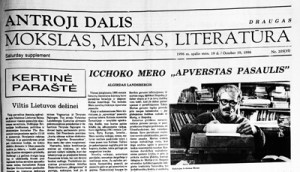
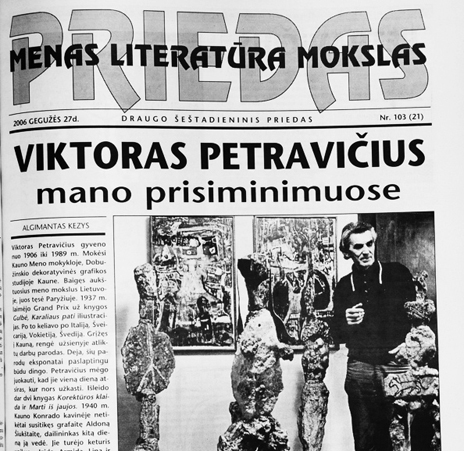
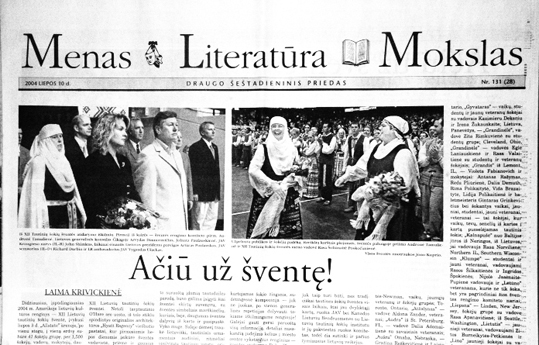
The Editors
During its one hundred years, over sixty editors worked at Draugas, and in-depth research about these men and women has yet to be undertaken. For most of the century, the average editorial staff consisted of about five modestly paid editors. Their workday usually commenced at dawn because the completed edition had to be submitted to the presses before noon. For many years, especially when the Linotype was the dominant typesetting technology, the editors were also required to typeset some of their work. Each editor was assigned to oversee a section of the paper and was responsible for collecting and editing material, writing articles and editorials, and attending and reporting on the numerous functions that dominated the Lithuanian community’s social and community life. The editors did interviews, but they avoided the more aggressive style of investigative reporting. Although Leonardas Šimutis was always the de facto editor in chief, in 1952 the Marian Fathers took firmer editorial control of the paper and appointed a moderator, whose responsibility was to make sure the paper adhered to the teachings of the Roman Catholic Church. This tradition ceased after about fifty years, when there were no more Lithuanian Marians in Chicago left to fill this role.
Glancing through the roster of editors (see Appendix E), almost all of them were college or university graduates, and their achievements and contributions are impressive. During the first two decades, some of the editors worked briefly at Draugas and then returned to Lithuania, many of them assuing influential positions in academia, the government, or the Roman Catholic Church hierarchy. Kazys Gineitis, while completing his undergraduate studies at the University of Chicago, was assistant editor of Draugas between 1917 and 1919. After graduating, he joined the Lithuanian diplomatic corps, eventually becoming Lithuania’s consul general in London and then its commercial agricultural attaché. Kazys Pakštas, a graduate of Fordham University and the University of Fribourg in Switzerland, chaired the geography department at the University of Lithuania in Kaunas, while Pranas Šivickis, a graduate of Valparaiso University, the University of Missouri, and the University of Chicago, established the zoology department there. After his proposals for a Lithuanian Constitution based on the U.S. Constitution were rejected, Rev. Antanas Maliauskis retreated to the University in Kaunas and chaired its department of sociology. Rev. Pranciškus Bučys returned to Lithuania in 1921 and within a few years became the general superior of the Marian Fathers and later was appointed a Bishop. Rev. Vincas Vizgirda and Rev. Fabijonas Kemėšis, after living and working for many years in the United States, came back to Lithuania, and tragically, at the onset of World War II, were both deported by the Soviets to Siberian forced labor camps, where Rev. Kemėšis lost his life.
Many of the editors were also influential community leaders or prolific authors, who made lasting contributions to the Lithuanian-American community as well as to their homeland. In light of their accomplishments, editing Draugas was almost a sideline for many of them. Leonardas Šimutis was an eminent Lithuanian political activist and statesman.41 Not quite thirty years old, he distinguished himself after World War I when, as the chief fundraiser of Tautos Fondas (the National Fund) in 1918, he raised $300,000 (about $11 million in today’s currency) toward supporting the newly founded Lithuanian state.42
In 1922, he was part of a delegation that met U.S. President Woodrow Wilson to request U.S. recognition of Lithuania‘s independence, which was granted by President Warren G. Harding in 1922. When the Soviets invaded Lithuania on June 15, 1940, it was Šimutis who took the initiative to call together a fragmented group of Lithuanian newspaper editors and community activists and persuaded them to settle their differences and work toward the common cause of expelling the invaders and ensuring that the United States did not recognize the Soviet occupation of Lithuania. Renowned for his conciliatory style, he established the Lithuanian American Council, a multi-organizational political activist group focused on restoring Lithuania‘s independence, and chaired it until 1965. He headed the Council‘s numerous delegations to various U.S. Secretaries of State, members of Congress, and Presidents Roosevelt, Truman, Eisenhower, and Kennedy to discuss Lithuania’s plight.
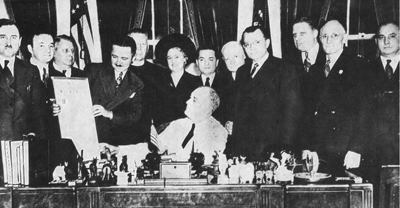
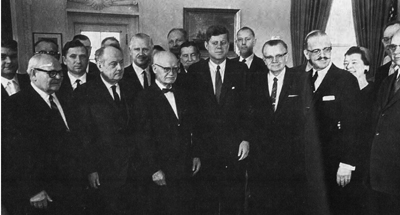
Other editors were also engaged in projects beyond the realm of Draugas, leaving an indelible mark on Lithuanian culture and simultaneously enriching the paper‘s content with their expertise. Bronius Kviklys, recognized for his informative articles and analytical editorials about conditions in Soviet-occupied Lithuania, gained knowledge in this area after first writing a four-volume geographic reference work, Mūsų Lietuva (Our Lithuania) documenting the history of Lithuania‘s villages and towns, and later authoring a seven-volume compilation about Lithuania‘s Catholic Churches. Kazys Bradūnas, considered one of Lithuania‘s major twentieth-century poets, authored over twenty books of verse and edited several books of literary criticism, including an anthology of Lithuanian literature in exile. Rev. Juozas Prunskis, holding a doctorate in canon law from the Catholic University of America, was a very productive journalist who not only authored many works in Lithuanian, but also published several informational ones in English about Communist and Nazi atrocities. Rev. Pranas Garšva wrote the history of the Lithuanian Marian Fathers. Česlovas Grinčevičius wrote several children‘s books, and for several years served as director of the Lithuanian World Archives. Danutė Bindokienė authored fiction and nonfiction works, among them a bilingual book about Lithuanian customs and traditions. Her successor, Dalia Cidzikaitė, recently published an analysis of the concept of “other” in Lithuanian prose. Vytautas Radžius for many years served as the head of Chicago‘s Lithuanian Opera Company, and current editor Laima Apanavičienė is a long-time Lithuanian language schoolteacher and, as the director of the Čiurlionis Art Gallery in Chicago, organizes and hosts monthly art exhibits.
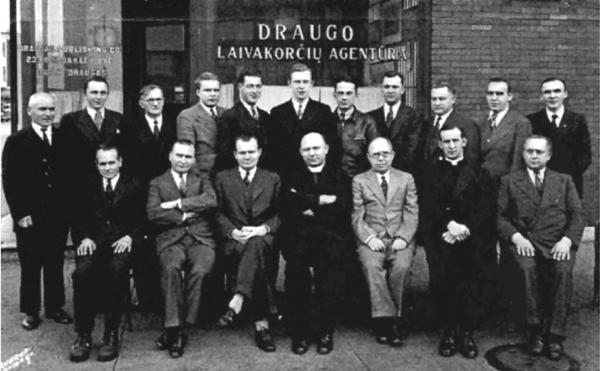
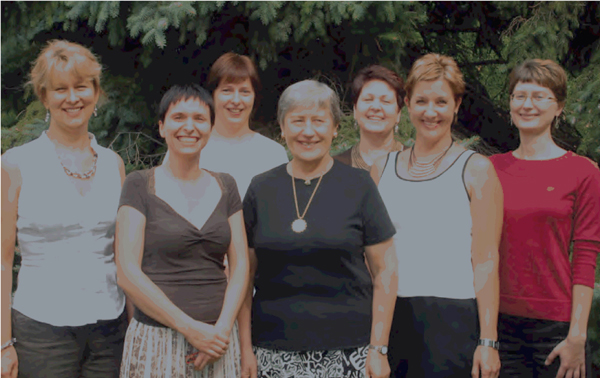
1990 to the Present
If prior to 1990, Draugas focused on “retain and regain,” the overwhelming challenge during the next two decades was “survive.” After Lithuania regained its independence, Draugas’s focus shifted to tracking developments in Lithuania, supporting Lithuania’s initiatives to gain membership in NATO and the European Union, and trying to decipher its ever-changing political landscape. In the early 1990s, Danutė Bindokienė broke tradition by being the first woman to be appointed editor-in-chief, a position she retained until 2007. If group pictures of editors prior to 1980 featured only male laity and clergy, photographs after the mid-1990s pictured mostly a female editorial staff. Attempting to attract new readers, Bindokienė experimented with various formats such as a separate weekly English language edition called Friend, which she herself edited during the last half of 1996, but which was discontinued because the paper’s owners determined that it was not financially feasible to hire an editor exclusively for this publication. She introduced new columns on culinary arts and gardening, but most importantly she started a ”Letters to thEditor” section, a radical change for a paper which never had a regular op-ed section and which amazingly for years seemed to hold the initial founders’ view that there could be only one true, qualified opinion.
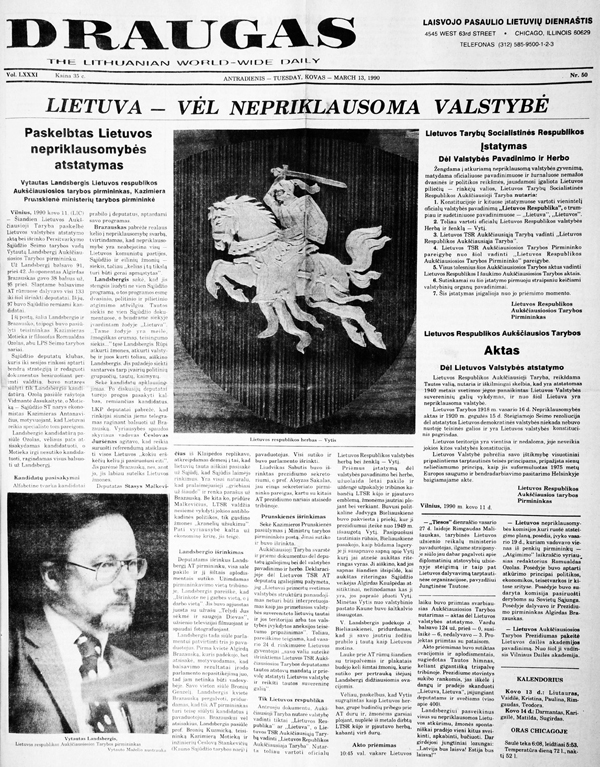
In the past, influxes of immigrants popularly referred to in the Lithuanian community as bangos (waves), have regenerated Lithuanian-American community life by introducing new ideas and people. By 1990, Lithuania started to experience a third massive emigration as its citizens left the country to seek better economic opportunities, mainly in North America, Europe, and Australia. It is estimated that between 1990 and 2006, 447,000 Lithuanians, over 11 percent of the population, emigrated. However, there is no clear information on how many actually settled in the United States, since many obtained temporary visas and then remained illegally.43 Combining totals from the 2000 U.S. Census and the Lithuanian government’s statistics department (www.stat.gov.lt), a rough estimate shows that there are at least 40,000 Lithuanian-born immigrants living in the United States who probably speak Lithuanian and are potential subscribers to Draugas. However, annually published circulation statistics, verified by the Draugas administrative office, show a subscriber base declining from 5,620 in 1996 to 3,200 in 2009. Unlike the second wave of émigrés, very few members of the third wave subscribe to the paper. The commercialization of the Internet in the mid-1990s, the availability of inexpensive computers with audio and visual communication devices, and most importantly the availability of continuous news twenty-four hours a day from a variety of Lithuanian and global sources, poses a very competitive threat, not only to Draugas, but also to the world’s largest print newspapers. The appearance of new print weeklies such as Amerikos Lietuvis (The Lithuanian American), the ad-driven free weeklies, such as Langas (Window) and Chicagos Aidai (Chicago’s Echoes), all without religious or ideological constraints and with more liberal editorial policies, also distracted potential subscribers. Although a wide range of explanations is given for the decline in subscribers, until a professional readership survey is completed, the reasons will remain speculative.
Today, Draugas is still published five days a week, but it is edited by a smaller staff. Dalia Cidzikaitė, its editor in chief, is assisted by one part-time and two full-time editors. Besides the editors, eight other editorial, technical, and administrative specialists assist in publishing the paper, and over fifty contributors provide material, the majority of them declining an honorarium. Under Cidzikaitė‘s editorial guidance, the paper remains a Christian, Roman Catholic oriented, publication. Probably, for the first time in its history, Draugas is much more open to diverse opinions, encouraging readers to submit well-documented opposing viewpoints, or at least express their thoughts in the “Letters to the Editor” column.44 In a recent interview, Cidzikaitė commented on the current mission of Draugas:
“Mano įsitikinimu, svarbiausia ‘Draugo’ misija – aprašyti JAV lietuvių gyvenimą. Jis tikrai verda: rengiami koncertai, parodos, susitikimai, renkama parama, vyksta diskusijos. Tikrai nepretenduojame būti intelektualams skirtu analitiniu leidiniu. Svarbu, jog ‘Draugas’ būtų lietuvių bendruomeninis laikraštis. Tikrai nenorime būti vien istorine vertybe, norime būti aktualūs ir reikalingi čia ir dabar”. 45
“I believe that the most important mission of Draugas is to write about the life of Lithuanians in the United States. It is really thriving: the are concerts, exhibits, meetings, fundraisers, discussions. We really are not pretending to be an analytical publication for intellectuals. It is important that Draugas be a Lithuanian community paper. We really do not want to merely be a historical icon; rather we want to be relevant and needed, here and now.”
Conclusion
After a hundred years, Draugas remains the only Lithuanian daily in North America. Its venerability makes it worthy of more than a brief historical overview, which can be cursory, incomplete and leave many unanswered questions. There are a multitude of studies that could be written about this newspaper, examining its content, objectivity, editorial positions and viewpoints, and how the background of its editors influenced the paper’s projected worldview in more detail.
Further questions remain about the paper’s impact on Lithuanian-American community life, as well as Lithuania itself. As its subtitle “The Lithuanian World-Wide Daily,” suggests, Draugas has always thought of itself as an important, integral part of Lithuania, and aspired to have a global Lithuanian readership. Ironically, today, Draugas probably has less name recognition in Lithuania than it did during Soviet times, when the press was censored, receipt of Draugas was forbidden, and cadres of “emigrantologists” criticized the émigré press, which created awareness amongst Lithuanians of the existence of overseas publications.46 Currently, when news is uncensored and readily available, Lithuania’s major internet news portals, Delfi.lt, Alfa.lt, and Draugas’s news partner Bernardinai.lt neglected to mention the newspaper’s centennial last July. Lithuania’s former President Valdas Adamkus, in a speech near Chicago on September 12, 2009, also supported this impression. He surmised that only 100 to 200 people in Lithuania subscribe to Draugas, and suggested that if a survey were to be conducted of pedestrians on a Lithuanian city street, probably only two out of ten people would have ever heard of the publication.47
Since neither Draugas nor other major Lithuanian newspapers are completely digitized, comparative content analysis, impact-measuring citation studies, and further investigations using Draugas as source material can never be accurately completed. Newspaper digitization remains expensive, and in today’s current economic climate, it is highly improbable that Lithuanian organizations in the U.S. or Lithuania can fund this initiative. The newspaper preservation programs supported by the U.S. Library of Congress recommend that newspapers first be microfilmed and then scanned into an electronic medium. Microfilm is still the preferred preservation format because of its longevity, especially if it is made of silver halide film and stored in a stable environment. The U.S. Newspaper Program’s Microfilming Preservation Guidelines can be accessed at http://www.loc.gov/preserv/usnppr.html, while information about the digitization process is provided by the National Digital Newspaper Program at http://www.loc.gov/ndnp/. For over twenty years, the Illinois Newspaper Project (INP) (http://www.library.illinois.edu/inp/index.html) has microfilmed both English-language and foreign-language newspapers published in Illinois. Supported by the National Endowment for the Humanities (NEH), the INP set out to microfilm Draugas, but in 2009 it ran out of funds and was unable to even begin this project. According to INP staff members, it is uncertain whether NEH funding will be available for microfilming retrospective collections of foreign-language publications. Figures obtained from INP officials estimate that it costs .25¢ to .50¢ for microfilming a single newspaper page, and about $1.00 per page to scan it and apply the appropriate search technology. A rough estimate of the cost of digitizing a year’s worth of the twelve-page daily Draugas and its twenty-four-page Saturday issue, in its current tabloid format, is about $6,000. The cost of conversion is high, but until the complete contents of Draugas can be readily accessed, a hundred years of meticulously collected history will slowly languish and eventually disintegrate on the shelves.
[See Appendices A, B, C, D, E}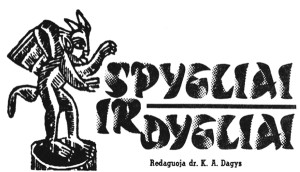
1. To determine if there were any English language academic studies published exclusively about Draugas, the following bibliographic and full-text databases were examined: America: History & Life; Communication & Mass Media Complete; EBSCO Academic Search Premier; Ethnic Newswatch; Historical Abstracts; ISI Web of Knowledge; MLA Bibliography; ProQuest Dissertations & Theses; Social Science Abstracts; Wilson Select Plus; and WorldCat. I would like to express my deepest appreciation to Jolanta Garlaitė, Bibliographer, and Silvija Velavičienė, Head of the Lituanica section of the Martynas Mažvydas National Library of Lithuania, who reviewed Lithuanian bibliographic sources and provided me with a list of Lithuanian language articles and books published about Draugas.
2 A conference honoring the centennial of Draugas entitled “Lietuvių išeivijos spauda: istorija ir dabartis” (Lithuanian Emigrant Press: History and Present) was held at Vytautas Magnus University in Kaunas on March 19-20, 2009. The following presentations were about Draugas: Bielskus, Evaldas, “ ‘Draugo’ savaitraštis: ‘vidinė’ bei ‘išorinė’ 1909–1916 m. numerių analizė” (An Internal and External Analysis of the Weekly Issues of Draugas in 1909–1916); Skirius, Juozas, ”Redaktorius Leonardas Šimutis ir dienraštis ‘Draugas’ (1927-1968)” (Editor Leonardas Šimutis and the daily Draugas (1927-1968); Antanaitis, Arūnas, “ ‘Draugo’ dienraščio redakcijos skiltis 1988-1990 m.” (The Editorial Section of the Draugas Daily from 1988–1990); Drunga, Mykolas, “ ‘Draugo’ reikšmė išeivijos visuomeniniam ir kultūriniam gyvenimui” (The Meaning of Draugas in the Emigrant‘s Social and Cultural Life); Petrauskaitė, Danutė, “Muzikinio gyvenimo aktualijos JAV lietuvių spaudoje (1879-1949)” (Musical Life in the U.S. Lithuanian Press (1879-1949).
3. Skirius, “JAV lietuvių laikraščiui ‘Draugui’ – 100 metų.” Juozas Skirius is also currently writing a biography of Leonardas Šimutis, editor-in-chief of Draugas for forty years.
4. Draugas issued a special Golden Anniversary issue on November 14, 1959. The following articles provide information about the paper’s origins: Pr. Pauliukonis, “Trys asmenys leido laikraštį. Pasikalbėjimas su buvusiu ‘Draugo’ redaktorium prel. K. Vasiu” (Three Persons Published the Newspaper. A Conversation with Former Draugas Editor Msgr. K. Vasys); Matas Zujus, “Ką aš atsimenu iš ‘Draugo’ praeities” (What I Remember from Draugas’s Past); Al Gimantas, “Nuo ‘Draugo’ administratoriaus iki sėkmingo verslininko. Pasikalbėjimas su P.S. Moliu buv. ‘Draugo’ tarnautoju 1914-1917“ (From Administrator of Draugas to Successful Businessman. An Interview with P.S. Molis, an Employee of Draugas between 1914 and 1917).
5. Velavičienė, “KGB Censorship and Surveillance of Publications by Lithuanian Emigres in North America,” and “Išeivijos spauda Lietuvoje per penketą sovietinio draudimo dešimtmečių.”
6. See the Supplement section of Vol. VI of Encyclopedia Lituanica, s.v. “Lithuanians in the United States.”
7. For additional information about literacy levels and practices of Lithuanian immigrants who settled in the U.S. between 1880 and 1920, see Daiva Maria Markelis, “ ’Jurgis Acquires the Reading Habit’: Language and Literacy in Early Lithuanian-American Immigrant Life,” 55–85.
8. Fainhauz, Lithuanians in the USA, 107, 148.
9. For further information about the Lithuanian-American press, see Works Cited for articles by Balys, Biržiška, Kučas, and Slavėnas.
10. Ambrose, The History of Chicago Lithuanians, 1869-1959, 225-250.
11. Julius Tamošiūnas, Lietuviškų periodinių leidinių bibliografija: 1832-1982,900-901.
12. Figure derived from bibliographic entries in Vaclovas Biržiška‘s Lithuanian Publications in the United States 1874-1910.
13. For additional information about Jonas Šliūpas, see Encyclopedia Lituanica, s.v.“ Šliūpas, Jonas.“ Refer to Works Cited for publications by Rev. William Wolkovich-Valkavičius, a monograph by Juozas Jakštas and its review by Sr. Virginia Marie Vytell, CJC.
14. Balys, “The American Lithuanian Press.”
15. Refer to memoir by Martynas Gudelis, aka Martin Gudell.
16. Kučas, Kun. Antanas Staniukynas, 123.
17. For additional information about the pastoral activities of Rev. Kaupas, see: Wolkovich-Valkavičius, Lithuanian Religious Life in America: A Compendium of 150 Roman Catholic Parishes and Institutions,143,156, 205.
18. Fainhauz, Lithuanians in the USA, 42.
19. The value of the dollar over time was calculated using the unskilled wage rate in Measuring Worth http://www.measuringworth.com.
20. Bronius Kaslas, “Kun. Jono Kasakaičio atsiminimai.“ (The Memoirs of Rev. Jonas Kasakaitis) Draugas. Part 4, November 14, 1959.
21. Kučas, Kun. Antanas Staniukynas, 126.
22. For further information about Kaupas’s social theories, see Pruskus, “Antanas Kaupas: Ižvalgos dėl nacionalinio identiteto ir socialinio. santarvės išsaugjimo,“ 131-143. Article can also be accessed at http://www.ceeol.com or in Remienė and Škiudaitė, „Draugui“ – 100: Už tikėjimą ir lietuvybę, 166-179.
23 See Appendix C.
24. Kiekviena bažnyčia daro gera dorišką itekmę ant visuomenės gyvenimo, bet šitame atžvilgyje katalikų bažnyčia stovi augščiau už kitas, nes joje daugiau autoriteto, daugiau tradicijos (padvos), daugiau meilės artimo, daugiau atsižiūrėjimo į dvasiškus ir doriškus žmonių reikalus. Jeigu tiesa yra, kad etika yra mokslas apie žmogaus priedermes kaslink Dievo, kaslink artimo ir kas link paties savęs, tai katalikų bažnyčioje etikos yra daugiausiai. Todel tai, jei bažnyčioms yra žadėta vaidinti didelę rolę visuomenės gyvenime, tai pirmoji rolė pripuola katalikų bažnyčiai.
Every church has a good moral influence on the life of a society, but in this respect the Catholic Church stands above the others because it has more authority, more tradition, more neighborly love, and pays more attention to the spiritual and moral needs of the people. If it is true that ethics is the science of a person’s obligations toward God, his neighbors, and himself, the Catholic Church has the greatest amount of ethics. Thus, if churches are destined to play a great role in the life of a society, the principal role falls to the Catholic Church. See page 261 in Draugas, December 23, 1909.
25. See citation from The Independent on page 186, which mentions the contributions of blacks to America’s exploration: Draugas, October 7, 1909. For another example, see “Atsitikimai Katalonijoje” (Events in Catalonia), Draugas, August 12, 1909.
26. “Delko žydai nera mylimi net laisvoje Amerikoje” (Why Jews are Not Loved Even in a Free America). Draugas, July 12, 1909, 14.
27. For the position of Draugas on labor issues, see “Redakcijos pastabos” (Editorial Remarks) in Draugas on December 16, 1909, and December 23, 1909.
28. Audronė V. Škiudaitė, “Užmirštasis ‘Draugo’ redaktorius kun. dr. Vincentas Vizgirda“ (The Forgotten Editor of Draugas, Rev. Dr. Vincentas Vizgirda) in „Draugui“ – 100: Už tikėjimą ir lietuvybę, Remienė and Škiudaitė, 106–111.
29. Fainhauz, Lithuanians in Multi-Ethnic Chicago, 41.
30 Ambrose, The History of Chicago Lithuanians, 1869-1959, 252-253.
31. See Appendix D for a list of locations.
32. For comments by Rev. Pranciškus Bučys, see “Pirmieji metai Seinų seminarijoje“ (The First Years at the Seiniai Seminary) in Remienė, „Draugui“ – 100: Už tikėjimą ir lietuvybę, 191.
The following are excerpts from remarks published by Danutė Bindokienė in “Dienraštis – visuomenės veidrodis,“ ( A Daily Newspaper is Society‘s Mirror), Draugas, September 1, 1995:
Nemanome ir su kita lietuvių periodika kariauti ar polemikuoti, nors kai kurie laikraščiai nuolat mėgina ’Draugo’ redakcijos kantrybę, bereikalingais puolimais. Iš dalies mus džiugina priekaištai, nes parodo ‘Draugo’ visapusiškumą, atsižvelgimą į visos lietuviškos visuomenės reikalus, neišskiriant nei vienos organizacijos, žmonių grupės, leidžiant pareikšti įvairias nuomones (Tik užmeskite akį į laiškų skyrių!)
It is impossible to fight or polemicize with the other Lithuanian periodicals, although certain newspapers continuously try the patience of the editors of Draugas with their unnecessary attacks. Actually, these reproaches gladden us, because they demonstrate the comprehensiveness of Draugas, which takes into consideration all of Lithuanian society’s issues, not omitting a single organization, group of people, allowing everyone to express their opinions. (Just take a look at the letters to the editor section!)
33. Leonardas Šimutis, “’Draugo’ nueitas kelias” (The Path Taken by Draugas). Draugas, November 14, 1959, Part 3.
34. Dalia Cidzikaitė, “ ’Draugas’ nėra vien istorinis reliktas, bet čia ir dabar aktualus leidinys” (Draugas is Not a Mere Historical Relic, but a Relevant Publication, Here and Now.) Bernardinai.lt. September 25, 2009. http://www.bernardinai.lt/index.php?url=articles%2F100255
35. Encyclopedia Lituanica, s.v.” Refugees.”
36. Prunskis, “Dienraščiui ‘Draugui’ 50 metų.”
37. According to 39 U.S. Code 3685, since 1960, the owners of periodicals are required to annually publish a “Statement of Ownership, Management, and Circulation.” Examined Statements were published in Draugas on October 11, 1963, October 19, 1972, October 10, 1978, and October 4, 1983.
38. Tamkevičius. S.J. “Editors of ‘The Chronicle of the Catholic Church in Lithuania’ about Publishing and Staff,” 49.
39. For allegations about Alseika’s connection with the KGB, see Lietuvių visuotinė enciklopedija, s.v.”Alseika, Vytautas Kazimieras.” Regarding his years at Draugas, see Vytautas Alseika, Trys dešimtmečiai emigracijoje: Nuo Roitlingeno iki Niujorko.
40. Danutė Jokimaitytė, “Menas – grožiui, grožis – gyvenimo tobulumui” (Art–for Beauty, Beauty to Improve Life) in „Draugui“ – 100: Už tikėjimą ir lietuvybę, 359.
41. For biographical information about Leonardas Šimutis, refer to Works Cited for articles by his colleague Juozas B. Laučka and his current biographer Juozas Skirius. See also Šimutis‘s monograph about the Lithuanian American Council and its review by J. Prutenis.
42. The value of the dollar over time was calculated using the 1918 unskilled wage rate in Measuring Worth http://www.measuringworth.com.
43. “Emigracija mažėja, tačiau išvyksta daugiau išsilavinusių jaunų žmonių“ (Emigration is Declining, However More Educated Younger People are Leaving), Bernardinai.lt., 11/09/2007, http://www.bernardinai.lt/index.php?url=articles/69617 According to the Lithuanian government’s statistics department, between 2001 and 2008, 13,911 Lithuanians officially declared that they were immigrating to the United States. See Statistics Lithuania. Table M3020104: Emigrants who have declared their departure by state of next residence, http://db1.stat.gov.lt/statbank/default.asp?w=1280. Retrieved on September 27, 2009. The 2000 U.S. Census, between 1990 and 2000, reported only 8,000 new Lithuanian immigrants and a total of 26,155 persons older than 18 years who were born in Lithuania and living in the United States. See. U.S. Census. Table FBP-1: Profile of Selected Demographic and Social Characteristics. 2000. People Born in Lithuania. http://www.census.gov/population/cen2000/stp-159/STP-159-Lithuania.pdf. Retrieved on September 27, 2009.
44. Dalia Cidzikaitė, “Kiekviena diena yra nauja diena” (Everyday is a New Day) in „Draugui“ – 100: Už tikėjimą ir lietuvybę, 284.
45. Dalia Cidzikaitė, “ ’Draugas’ nėra vien istorinis reliktas, bet čia ir dabar aktualus leidinys” (Draugas is Not a Mere Historical Relic, but a Relevant Publication, Here and Now), Bernardinai.lt, September 25, 2009. http://www.bernardinai.lt/index.php?url=articles%2F100255
46. Velavičienė, “KGB Censorship,” 50.
47. “ ’Ne aš vertinu, ne jūs vertinsite, bet istorija įvertins.’ Prezidento Valdo Adamkaus kalba.” (I will not evaluate, you will not evaluate, but history will evaluate). Speech by President Valdas Adamkus. Transcribed by Dalia Cidzikaitė, Draugas, September 15, 2009.
WORKS CITED
Alseika, Vytautas. Trys dešimtmečiai emigracijoje: Nuo Roitlingeno iki Niujorko (Three Decades in Emigration: From Roitlingen to New York). Vilnius: Mintis, 1977.
Ambrose, Alex. The History of Chicago Lithuanians, 1869-1959. Chicago: Lithuanian American Historical Society, 1967.
Balys, J.P. “The American Lithuanian Press.” Lituanus 22 (1976): 42-53. http://www.lituanus.org/1976/76_1_02.htm
Bindokienė, Danutė. “Devyniasdešimtasis ’Draugo’ gimtadienis” (The Ninetieth Birthday of Draugas). In Draugas, užsienio lietuvių dienraštis, 90 (Draugas, an Overseas Lithuanian Daily is 90 Years Old). Chicago: Draugas, 1999.
Biržiška, Vaclovas. “The American Lithuanian Publications, 1875-1910.” Journal of Central European Affairs 18 (1959): 396-408.
________. Lithuanian Publications in the United States 1874 –1919. Edited by Stasė Vaškelis. Chicago: Institute of Lithuanian Studies, 1994.
Cidzikaitė, Dalia. “ ’Draugas’ nėra vien istorinis reliktas, bet čia ir dabar aktualus leidinys” (Draugas is Not a Mere Historical Relic, but a Relevant Publication, Here and Now). Bernardinai.lt. September 25, 2009. http://www.bernardinai.lt/index.php?url=articles%2F100255
Draugas. Anniversary Banquet to Commemorate Sixty Years in Chicago. Chicago, 1972.
Fainhauz, David. Lithuanians in Multi-Ethnic Chicago. Chicago: Lithuanian Library Press, Inc., 1977.
——————. Lithuanians in the USA: Aspects of Ethnic Identity. Chicago: Lithuanian Library Press, Inc., 1991.
Lietuvių Katalikų Spaudos Draugija. “Draugo deimantinė sukaktis“ (The Diamond Jubilee of Draugas). In Draugas: The Lithuanian Friend. Chicago: Lietuvių Kataliklų Spaudos Draugija, 1985.
Garšva, Pranas. “Dienraščiui ‘Draugui’ – šešiasdešimt metų” (Draugas Daily–Sixty Years). In Jungtinių Amerikos Valstybių lietuvių senosios išeivijos istorijos, gyvenimo, veiklos ir darbų apžvalginė paroda (An exhibit surveying the early U.S. Lithuanian immigration’s history, life, activities, and work). Edited by Bronius Kviklys, 47-59. Chicago: Draugas, 1976.
——————. Negęstanti Šviesa: Marijonų veikla Amerikoje (An Inextinguishable Light: The Activities of the Marians in America). Elizabeth, N.J.: Prelatas Mykolas G. Kemėžis, 1964.
Gaučys, Povilas, comp. A Bibliography of the Lithuanian Press Outside Lithuania, 1970-1974. Chicago: Institute of Lithuanian Studies Press, 1977.
________. A Bibliography of the Lithuanian Press Outside Lithuania, 1975–1979. Chicago: Institute of the Lithuanian Studies Press, 1984.
Gudell, Martin. Lo Que Oi En La U.R.S.S. Mexico.D.F.: Ediciones Estudios Sociales, 1946.
Jakštas, Juozas. Dr. Jonas Šliūpas. 2nd ed. Šiauliai: Saulės Delta, 1996.
Kučas, Antanas. “Lietuvių sčpauda XX amžiuje” (The Lithuanian Press in the 20th Century). In Amerikos lietuvių istorija. (Lithuanians in the United States: A History), 391-434. Boston: Lietuvių Enciklopedijos Leidykla, 1971.
________. Kun. Antanas Staniukynas. Roma: Lietuvių Katalikų Mokslo Akademija, 1965.
Laučka, Juozas B. “Leonardo Šimučio 80 metų sukaktį minint” (Commemorating the 80th Anniversary of Leonardas Šimutis). Aidai (November 1972): 392-394.
Markelis, Daiva Maria. “ ‘Jurgis Acquires the Reading Habit’: Language and Literacy in Early Lithuanian-American Immigrant Life.“ Ph.D. dissertation, University of Illinois at Chicago, 1999.
Prunskis, Rev. Juozas. “Dienraščiui ‘Draugui’ 50 Metų” (The Daily Draugas is 50 Years Old). Aidai (August 1959).
Prunskis, Rev. Juozas. “Spaudos ir akcijos centras” (Press and Activity Center). In Amžinybei ir tėvų žemei: TT. Marijonų darbai naujojo kultūros centro dedikacijos proga (For Eternity and the Homeland: The Work of the Marians on the Occasion of the Dedication of the New Cultural Center). Chicago: Lietuvių Katalikų Spaudos Draugija, [1957?].
Pruskus, Vladas. “Antanas Kaupas: Įžvalgos dėl nacionalinio identiteto ir socialinio santarvės išsaugjimo“ (Insights into the Preservation of National Identity and Social Concord). LOGOS: A Journal of Religion, Philosophy, Comparative Cultural Studies and Art 44 (2005): 131-143.
Prutenis, J. “L. Šimučio veikalas apie ALTĄ” (Review of the Amerikos Lietuvių Taryba: 30 metų Lietuvos laisvės kovoje, 1940-1970 by Leonardas Šimutis.) Aidai (March 1972): 499.
Remienė, Marija Bareikaitė, comp., and Audronė Viktorija Škiudaitė, ed. „Draugui“ – 100: Už tikėjimą ir lietuvybę (Draugas – 100: For Faith and Lithuania). Vilnius: Lietuvių Katalikų Spaudos Draugija, 2009.
Rimšelis, Rev. V., ed. Draugas: The Lithuanian Friend, 1909-1979. Chicago: Lietuvių Katalikų Spaudos Draugija, 1979.
Šimutis, Leonardas. Amerikos Lietuvių Taryba: 30 metų Lietuvos laisvės kovoje, 1940-1970. (The Lithuanian American Council: A 30 Year Struggle for the Liberation of Lithuania, 1940-1970). Chicago: Lithuanian American Council, 1971.
Juozas Skirius, “JAV lietuvių laikraščiui ‘Draugui’ – 100 metų” (U.S. Lithuanian Newspaper Draugas – 100 Years), Draugas. July 25, 2009.
_________. “Prisimenant Leonardą Šimutį, Jo 110-jų gimimo metinių proga” (In Memory of Leonardas Šimutis on the Occasion of His 110th Birthday). Draugas. August 21, 2002.
Slavėnas, M.G. “The Lithuanian Ethnic Press,” in The Ethnic Press in the United States, ed. Sally M. Miller, 237-245. New York: Greenwood Press, 1987.
Tamkevičius, Sigitas S.J. “Editors of ‘The Chronicle of the Catholic Church in Lithuania’ about Publishing and Staff.” In The Church, the “Kronika,” and the KGB Web, edited by Vidas Spengla and translated by Saulius Girnius. Vilnius: Katalikų Akademija, 2002.
Tamošiūnas, Julius. Lietuviškų periodinių leidinių bibliografija: 1832-1982 (The Bibliography of the Lithuanian Periodical Press). Kaunas: Julius Tamošiūnas, 1991.
Velavičienė, Silvija. “KGB Censorship and Surveillance of Publications by Lithuanian Émigrés in North America During Five Decades of the Cold War.” Lituanus 55 (2009): 37-56.
——————. “Išeivijos spauda Lietuvoje per penketą sovietinio draudimo dešimtmečių” (The Lithuanian Exile Press During Five Decades of Soviet Censorship). Knygotyra 44 (2005): 193-208.
Vytell, Sister Virginia Marie, CJC. “Dr. Jonas Šliūpas (1861-1944).” Lituanus. 37 (1991) http://www.lituanus.org/1991_1/91_1_07.htm
Wolkovich-Valkavičius, Rev. William. “Jonas Šliūpas (1861-1944) – Physician-Activist, Writer – Note.” Lituanus 48 (2002) http://www.lituanus.org/2002/02_1_08.htm
________. “Jonas Šliūpas: The Most Controversial of Them All” In Lithuanian Religious Life in America, A Compendium of 150 Roman Catholic Parishes and Institutions, Vol. 2, Pennsylvania.
48-53. Norwood, MA: Lithuanian Religious Life in America, 1996. ________. Lithuanian Religious Life in America, A Compendium of 150 Roman Catholic Parishes and Institutions. Vol 3. The Midwest and Beyond. Norwood, MA: Lithuanian Religious Life in America, 1998.
 DRAUGAS Lithuanian World Wide News
DRAUGAS Lithuanian World Wide News
